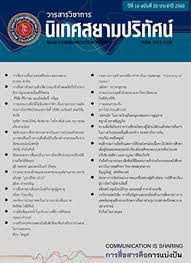Communication Behavior, Expectations and Identity of the Youth Presentation to Heterosexual Relationships on Social Networks Like Facebook.
Main Article Content
Abstract
This research is a survey research. The purposes are : 1.) to study the communication behavior of the youth on social networking ‘Facebook’. 2.) to study the expectations of the youth on social networking ‘Facebook’. 3.) to study the presentation of Identity of the youth to social and to build relationships with Heterosexual friends on social networking ‘Facebook’, and 4.) to study the relationship between communication behaviors, the expectations and identity of the youth whom using social networking ‘Facebook’. , total amount 428 persons. The research methods was a questionnaire, statistics (used in the research were percentage, mean and the correlation coefficient.), processed using statistical program. The results of the research Communication behavior, the expectation and the presentation of Identity of the youth on social networking ‘Facebook’, the youth samples use the Internet as a medium for communication and use the computer as a tool for communication. It is also a channel for modern communication. The presenting identity through social media ‘Facebook’ is a channel of youth on nowadays, by using modern technology. The behavior of youth in Thai society is changing as technology advances. Young men and women can relate freely. And there is a type of communication using the Internet is connecting between their relationships, brings faster communication. It can express the passion around things openly. For cyber world, the studying youth will pay attention or live life to touch the cyber world widely. It shows that the young men and women can be in thought leadership, unlike previous Thai society. The online or cyberspace is a place for youth to meet their expectations than the real world. In the real world, one person is the one identity (One Body, One Identity). But in social networks it is possible that one person can have multiple identities at the same time (One Body, Multiple Identity) without any restrictions. Identity in this society youth can change their needs all the time, such as today is presenting themselves as a sweet and healthy girl, tomorrow may be change the hip-hop looks to watch concerts with their friends. Expectations from social networking, youth will express themselves according to their needs and emotions. By using the symbol or images, such as press the button ‘Like’ to replace the expression of the words of Facebook Friends, To let other Facebook members can recognize identity expressed in different ways as possible. And understand that it is the true identity in the real world.
Article Details
References
กิตติ กันภัย. (2543). การสื่อสารผ่านคอมพิวเตอร์ในสังคมสารสนเทศ มองสื่อใหม่ มองสังคมใหม่. กรุงเทพฯ: เอดิสัน เพรส โพรดักส์
ขวัญเรือน กิติวัฒน์, (2531). สื่อมวลชนกับการสร้างความเป็นจริงทางสังคม, วารสารนิเทศศาสตร์.จุฬาลงกรณ์มหาวิทยาลัย.
ชูศรี งามประเสริฐ . (2541). การแอบมองและจ้องดูที่ปรากฏในภาพยนตร์. (วิทยานิพนธ์มหาบัณฑิต. จุฬาลงกรณ์มหาวิทยาลัย).
ดารินทร์ สวัสดิ์เสวี (2545) . การแปลงตัวตนในห้องสนทนาบนอินเทอร์เน็ต. (วิทยานิพนธ์มหาบัณฑิต. จุฬาลงกรณ์มหาวิทยาลัย).
นันดา วีรวิทยานุกูล. (2544) . “สตรีกับอัตลักษณ์ .” สตรีศึกษา: ผู้หญิงกับประเด็นต่าง ๆ . กรุงเทพมหานคร: สำนักงานการส่งเสริมและประสานงานสตรีแห่งชาติ,
ปรมะ สตะเวทิน. (2540) . หลักนิเทศศาสสตร์ กรุงเทพมหานคร: ห้างหุ้นส่วนจำกัดภาพพิมพ์.
พิสิษฎ์ นาสี (2554) .การนำเสนอตัวตนของนักศึกษาปริญญาตรี ผ่านการบริโภคสินค้าประดิษฐ์กาย. สาขาวิชาจิตวิทยาการศึกษาและการแนะแนว มหาวิทยาลัยเชียงใหม่.
ภาสกร จิตใคร่ครวญ (2553) .เทคโนโลยีของสื่อใหม่และการนำสนอตัวตนต่อสังคมกับพฤติกรรมการสื่อสารบนเครือข่ายสังคมออนไลน์. สาขาวิชาการประชาสัมพันธ์.จุฬาลงกรณ์มหาวิทยาลัย.
ยุบล เบ็ญจรงค์กิจ, 2534. การวิเคราะห์ผู้รับสาร, กรุงเทพมหานคร: คณะนิเทศศาสตร์. จุฬาลงกรณ์มหาวิทยาลัย.
วรรณี ศิริรัตน์รุ่งเรื่อง (2547) .ตัวตนและการนำเสนอตัวตนของผู้หญิงในเว็บไซต์หาคู่. สาขาวิชานิเทศศาสตร์บัณฑิตวิทยาลัย มหาวิทยาลัยธุรกิจบัณฑิตย์.
วิเชียร เกตุสิงห์. (2543) . การวิจัยเชิงปฏิบัติการ. พิมพ์ครั้งที่ 4.กรุงเทพมหานคร:โรงพิมพ์และทำปกเจริญผล.
ศุจิกา ดวงมณี (2539) . การเผยแพร่ข้อมูลข่าวสารผ่านwwwของสื่อมวลชนไทย. (วิทยานิพนธ์ปริญญามหาบัณฑิตจุฬาลงกรณ์มหาวิทยาลัย).
ศุนิสา ทดลา (2542) .รูปแบบพฤติกรรมการสื่อสารในห้องสนทนาบนเครือข่ายอินเทอร์เน็ต. (วิทยานิพนธ์นิเทศศาสตรมหาบัณฑิต จุฬาลงกรณ์มหาวิทยาลัย).
ศุภนาฏ บัวบางพลู. (2546) พฤติกรรมการสื่อสาร ความคาดหวัง การใช้ประโยชน์และความพึงพอใจในเทคโนโลยีสารสนเทศระบบเครือข่ายอินทราเน็ตของพนักงานในกลุ่มบริษัทเครือเจริญโภคภัณฑ์ (วิทยานิพนธ์นิเทศศาสตรมหาบัณฑิต จุฬาลงกรณ์มหาวิทยาลัย).
ภาษาอังกฤษ
BarztA. E. (1999) . Basic Statistical Concepts. New Jersey: Prentice –Hall.
Bloom, Benjamin S, Thomas J. and Madaus F. (1971) . Handbook on Formative and Summative Evaluation of Student Learning. New York: McGraw-Hill Book Company.
Friendster Valued At Just $26.4 Million In Sale (Online) .Available from: http://www.techcrunch.com/2009/12/15/friend-valued-at-just-26-4-million-in-sale/(2010,December)
Klapper,Joseph T. (1960) . The Effect of Mass Communication. New York: The Free Press.
Mccomb, Maxwell and Becker.Le. (1979) . Using mass Communication Theory. New York: Pren picehall.
Mcquail,Denis. (2005) . Mass Communication Therory.5th ed.London: SAGE Publications.
Palmgreen, P., Wenner, L.A., & Rayburn, J.D. (1981) . Gratification discrepancies and news program choice. Communication Research, 8, 451-478.
Rayburn, J.D., Palmgreen, P., & Acker, T. (1984) . Media gratifications and choosing a morning news program. Journalism Quarterly, 61, 149-156.
Rayburn, J.D., Palmgreen, P., & Acker, T. (1984) . Media gratifications and choosing a morning news program. Journalism Quarterly,
Roger. EM. (1976) . Communication and Development: The passing of dominant paradigm, Communication Research.
Schramm Wiblur. (1973) . Men Message and Media: A look at Mass Communication. New York: Harper and Roe Pulisher.
Shannon,Chaud E. And Weaver. The Mathermatical.Theory, of Communication Virbra


